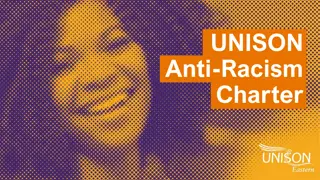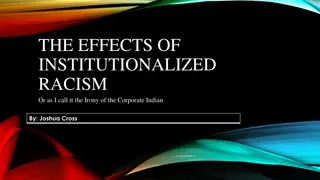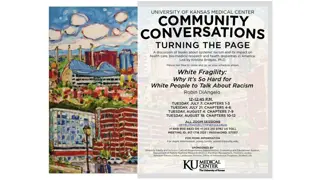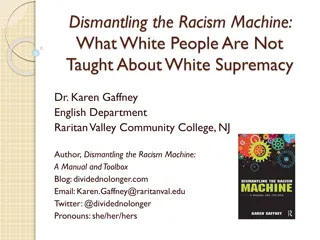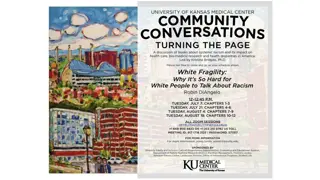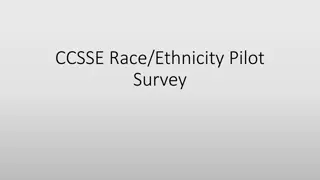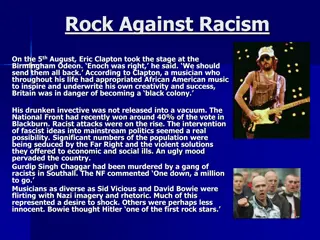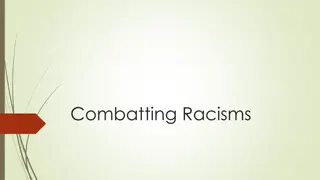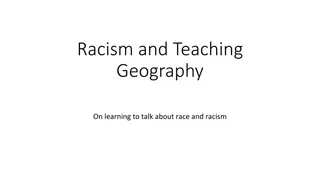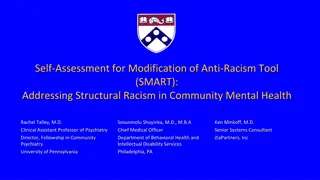Addressing Racism in Public Health Practice: A Call to Action by Professor Kevin Fenton
The killings of Black Americans have highlighted systemic racism in the U.S., leading to global recognition of racism as a public health crisis. Professor Kevin Fenton emphasizes the need to view racism as a public health issue, prompting strategic initiatives in policies, practices, and services. The content delves into the complexities of race, racism, and their impact on health, stressing the urgency of embedding anti-racism in public health practice to tackle structural inequities and promote optimal health outcomes.
Download Presentation

Please find below an Image/Link to download the presentation.
The content on the website is provided AS IS for your information and personal use only. It may not be sold, licensed, or shared on other websites without obtaining consent from the author.If you encounter any issues during the download, it is possible that the publisher has removed the file from their server.
You are allowed to download the files provided on this website for personal or commercial use, subject to the condition that they are used lawfully. All files are the property of their respective owners.
The content on the website is provided AS IS for your information and personal use only. It may not be sold, licensed, or shared on other websites without obtaining consent from the author.
E N D
Presentation Transcript
Embedding anti Embedding anti- -racism in public health practice public health practice racism in Professor Kevin Fenton MD PhD FFPH Regional Director, PHE London & Regional Director of Public Health, NHS London @ProfKevinFenton September 2020
Introduction Introduction The killings of Rumain Brisbon, Tamir Rice, Akai Gurley, Dante Parker, Michael Brown, Eric Garner, and many other Black Americans, have brought global attention to racial inequities involving police brutality in the United States and the depth of systemic racism in the U.S. Amid the outrage and pain related to these acts of overt racism and violence, government leaders as well as health organisations around the world are affirming racism as a serious public health crisis. Framing racism as a public health issue compels organisations and governmental units across the country to address the crisis in the broad, systemic ways that other threats to public health have been addressed over time. These can include strategic initiatives in policies, practices, enforcement, education, and support services. @ProfKevinFenton 3
Content Content 1. Reflections on race and racism 2. Racism and health 3. COVID-19, inequalities and structural determinants 4. Embedding anti-racism in public health practice: Where next? @ProfKevinFenton 4
Race and racism Race and racism Race and racism are not interchangeable constructs. Each needs its own distinct conceptualisation, measurement, and analysis for public health research. Race is a social construction with no biological basis, whereas racism refers to a social system that reinforces racial group inequity. Racialisation is the process by which meaning and value are ascribed to socially determined racial categories, and each racial category occupies a different position in the social hierarchy. For example, being Black in America (and increasingly the United Kingdom) has negative implications for educational and professional trajectories, socioeconomic status, and access to health care services and resources that promote optimal health, which in combination, may reduce or exacerbate health risks. In a racially stratified society, White lives are inherently valued over Black lives. @ProfKevinFenton 5
Race and Racism Race and Racism Racism is a wicked problem - complex problems that are highly resistant to solutions and that are characterized by high difficulty and disagreement about the nature and cause of the problem and their potential solutions. Racism is a system based on race that unfairly disadvantages some individuals and communities, and advantages others. Racism also may be considered a fundamental determinant of health because it is a dynamic process that endures and adapts over time, and because it influences multiple mechanisms, policies, practices and pathways that ultimately affect health. The health consequences of living in a racially stratified society are illustrated by a myriad of health outcomes that systematically occur along racial lines, such as disproportionately higher rates of infant mortality, obesity, deaths caused by heart disease and stroke, and an overall shorter life expectancy for Blacks in comparison with Whites. @ProfKevinFenton 6
Racism: A public health issue Racism: A public health issue Racism is common: in one national survey in the United Kingdom, 25- 40% of participants said they would discriminate against ethnic minorities; a third of people from ethnic minorities constrain their lives through fear of racism; reported hate crimes have more than doubled between 2013 and 2020, the majority of which were racial (78,991), representing an 11% increase over the previous year. Disparities between ethnic minority and majority groups in housing, education, arrests, and court sentencing are believed to be due to racism, not simply to economic sources. Although both race and racism are relevant to health, typically only race is included as a research question, variable, or topic in most health studies. Race, as it is conventionally conceptualized and operationalized in public health research, is not an adequate proxy measure for racism. In addition, controlling for race in statistical analysis is a common practice in public health research and the research of other health professions. @ProfKevinFenton 7
Racism and health in the Racism and health in the UK UK
What do we know about racism and its What do we know about racism and its impact on public health? impact on public health? Race Equality Foundation (2007) People from minority ethnic groups experience poor treatment due to the negative attitudes of others regarding their character or abilities. This occurs in their day-to-day interactions with other people as well as in their access to and interactions with services. Racist attitudes have been shown to affect health in a variety of ways. Understanding these processes is important for the development of effective policies to reduce the health disadvantage experienced by people from minority ethnic groups in the UK The Health Foundation (2020) Racial discrimination affects people s life chances negatively in many ways. For example, by restricting access to education and employment opportunities. People from black and minority ethnic groups tend to have poorer socioeconomic circumstances, leading to poorer health outcomes. The stress associated with being discriminated against based on race directly affects people s mental and physical health. @ProfKevinFenton 9
Lived experiences of Black Asian and Lived experiences of Black Asian and Minority Ethnic communities in the UK Minority Ethnic communities in the UK The UK has become more ethnically diverse. The proportion of people identifying as White British in England and Wales decreased from 87.4% in 2001 to 80.5% in 2011. There are disparities between ethnic groups in all areas of life affected by public organisations. Some are more pronounced than others or have a greater impact on people s life chances and quality of life. In some areas, disparities are reducing, while in others, they are static or increasing. Asian and Black households and those in the Other ethnic group were more likely to be poor and were the most likely to be in persistent poverty Households of Bangladeshi, Pakistani, Black, Mixed and Other backgrounds were more likely to receive income-related benefits and tax credits than those in other ethnic groups. The ethnic minority population is more likely to live in areas of deprivation, especially Black, Pakistani and Bangladeshi people. @ProfKevinFenton 10
Employment Employment Substantial differences remain in their participation in the labour market; around 1 in 10 adults from a Black, Pakistani, Bangladeshi or Mixed background were unemployed compared with 1 in 25 White British people. Although women from Pakistani and Bangladeshi backgrounds were the least likely to be employed, the proportion who were in work has increased substantially since 2004. While employment rates among people from Pakistani and Bangladeshi backgrounds have been improving, these populations remain more likely to be in low skilled, low paying occupations than other ethnic groups. They also have higher rates of self-employment. Pakistani or Bangladeshi employees received the lowest average hourly pay, which was 4.39 per hour less in the last three months of 2016 than Indian employees who received the highest average hourly pay. @ProfKevinFenton 11
Housing Housing The households that are most likely to rent social housing were headed by someone in the African, Caribbean, Other Black, Bangladeshi, Irish and Arab groups, or the Mixed groups other than Mixed White and Asian. As a group, ethnic minority households are also much more likely to rent privately than White British households and to spend a higher proportion of their incomes on rent, regardless of whether they rent from a social or private landlord. Their housing tends to be of lower quality, particularly among households of Pakistani origin, and overcrowding is more common, especially among households of Bangladeshi origin. Overcrowding affects ethnic minority households disproportionately, and London had one of the highest rates of overcrowding of all regions of England. @ProfKevinFenton 12
Health Health There are differences between ethnic groups across a range of health-related behaviours and preventable poor outcomes, and each ethnic group exhibits both healthy and unhealthy behaviours. More than half of adults in all ethnic groups other than the Chinese group were overweight (having a Body Mass Index of 25 and over), and this was particularly so among the White and Black ethnic groups, affecting 2 out of 3 White and Black adults. Most Asian groups express lower levels of satisfaction and less positive experiences of NHS General Practice services than other ethnic groups and there are differences in the prevalence of mental ill-health, its treatment and outcomes between ethnic groups. In the general adult population, Black women were the most likely to have experienced a common mental disorder such as anxiety or depression in the last week, and Black men were the most likely to have experienced a psychotic disorder in the past year. Of those receiving psychological therapies, White adults experienced better outcomes than those in other ethnic groups. Black adults were more likely than adults in other ethnic groups to have been sectioned under the Mental Health Act. @ProfKevinFenton 13
COVID COVID- -19: Inequalities 19: Inequalities and structural and structural determinants determinants
Health inequalities and COVID Health inequalities and COVID- -19 19 PHE s recent review: Disparities in the risks and outcomes of COVID-19 confirms that COVID 19 has replicated existing health inequalities and, in some cases, has increased them. This reinforces the need for targeted action. Age-standardised COVID-19 mortality rates (March to May 2020, England and Wales) geographical representation Age-standardised mortality rates, all deaths and deaths involving COVID-19, Index of Multiple Deprivation, England, deaths occurring between 1 March and 31 May 2020 Source: ONS @ProfKevinFenton 15
COVID COVID- -19 Ethnicity death rates 19 Ethnicity death rates Rate of COVID-19 death by ethnic group and sex relative to the White population, England and Wales, 2 March to 15 May 2020 PHE s disparities report and other emerging evidence has also demonstrated a disproportionate impact on BAME communities: Critical care admission was 28% more likely in South Asian and 36% more likely in Black ethnic groups, compared to the White group (after taking into account age, sex, location, deprivation and comorbidities) Risk of death was between 10- 50% higher amongst BAME communities compared to people of White British ethnicity after accounting for the effect of age, sex, age, deprivation and region @ProfKevinFenton 16
Ethnicity Ethnicity All positive cases with specimen dates up to 19 September 2020 All positive cases with specimen dates up to 19 September 2020 Number of people tested under Pillar 1 and 2, and percentage (%) by ethnic group and week Week - number (%) 35 Ethnic group 33 34 36 37 38 White 3,481 (54.5) 3,912 (61.0) 4,945 (65.5) 9,979 (68.3) 12,551 (69.1) 8,096 (71.0) Indian (Asian or Asian British) Pakistani (Asian or Asian British) Other Asian / Asian British Black / African / Caribbean / Black British Mixed / Multiple ethnic groups Other ethnic group 524 ( 8.2) 1,078 (16.9) 451 ( 7.1) 413 ( 6.5) 170 ( 2.7) 272 ( 4.3) 459 ( 7.2) 833 (13.0) 343 ( 5.4) 432 ( 6.7) 160 ( 2.5) 269 ( 4.2) 423 ( 5.6) 897 (11.9) 370 ( 4.9) 396 ( 5.2) 171 ( 2.3) 348 ( 4.6) 757 ( 5.2) 1,487 (10.2) 763 ( 5.2) 728 ( 5.0) 337 ( 2.3) 550 ( 3.8) 1,060 ( 5.8) 1,943 (10.7) 1,212 (10.6) 918 ( 5.1) 775 ( 4.3) 365 ( 2.0) 559 ( 3.1) 669 ( 5.9) 531 ( 4.7) 360 ( 3.2) 240 ( 2.1) 287 ( 2.5) Cumulative number and rate of Pillar 1 and Pillar 2 COVID-19 cases (per 100,000) by ethnicity (n=339,901)* Ethnic group Count Population Rate 95% Cl Rates exclude 30,272 COVID-19 cases for whom ethnicity is to be confirmed 230,451 15,596 19,380 13,692 14,953 4,701 10,856 30,272 47,010,723.6 1,532,380.8 1,303,426.3 1,850,400.1 2,104,814.3 1,550,543.4 624,889.4 - 490.2 1,017.8 1,486.9 739.9 710.4 303.2 1,737.3 - 488.2- 492.2 1,002.0-1,033.8 1,466.2-1,507.8 727.7- 752.4 699.2- 721.9 294.7- 312.0 1,705.2-1,770.0 - White Indian (Asian or Asian British) Pakistani (Asian or Asian British) Other Asian / Asian British Black / African / Caribbean / Black British Mixed / Multiple ethnic groups Other ethnic group Unknown Total Data for ethnicity were available for 91.5% Pillar 1 cases and 90.7% Pillar 2 cases 339,901 @ProfKevinFenton 17
Ethnicity cases by week Ethnicity cases by week All positive cases with specimen dates up to 19 September 2020 All positive cases with specimen dates up to 19 September 2020 @ProfKevinFenton 18
Ethnicity cases by week Ethnicity cases by week All positive cases with specimen dates up to 19 September 2020 All positive cases with specimen dates up to 19 September 2020 @ProfKevinFenton 19
Ethnicity cases by week and by age group Ethnicity cases by week and by age group All positive cases with specimen dates up to 19 September 2020 All positive cases with specimen dates up to 19 September 2020 @ProfKevinFenton 20
Ethnicity cases by week by region Ethnicity cases by week by region All positive cases with specimen dates up to 19 September 2020 All positive cases with specimen dates up to 19 September 2020 @ProfKevinFenton 21
COVID COVID- -19 and BAME groups 19 and BAME groups Social, cultural and structural determinants Social, cultural and structural determinants @ProfKevinFenton 22
COVID COVID- -19: Understanding racism s impact 19: Understanding racism s impact Stakeholders stressed that considering racism as causative is an important step in developing the COVID-19 research agenda and response from health services. It moves the discussion away from biological differences and access and towards prevention and the impact of societal structures on rates of illness. The investigation of specific risk factors for COVID-19 in ethnic minority groups may be vital if we are to develop equity in efficacy of treatment. For example, is the higher likelihood of severe disease or poorer response to COVID-19 treatment in African-Caribbeans due to biology or is it a reflection of the role of perceived racism in its development and persistence? Stakeholders felt that the investigation of racism's pathophysiological, cognitive, or psychophysiological correlates could offer new avenues for treatment and more efficacious management. Developing a deeper understanding of possible links between racism and health should be seen as a prerequisite for initiatives to decrease impact at a community and individual level. @ProfKevinFenton 23
Anti Anti- -racism in public racism in public health health
What is anti What is anti- -racism? racism? Anti-racism is the practice of identifying, challenging, and changing the values, structures and behaviours that perpetuate systemic racism. Anti-racism is an active way of seeing and being in the world, in order to transform it. Being antiracist is based on the conscious efforts and actions to provide equitable opportunities for all people on an individual and systemic level. People can act against racism by acknowledging personal privileges, confronting acts of racial discrimination, and working to change personal racial biases. Anti-racism is an educational and organising framework that seeks to confront, eradicate and/or ameliorate racism and privilege (Bonnett, 2000). An anti-racism approach often includes a structural analysis that recognises that the world is controlled by systems, with traceable historical roots, that batter some and benefit others. @ProfKevinFenton 25
What is anti What is anti- -racism racism Because racism occurs at all levels and spheres of society (and can function to produce and maintain exclusionary "levels" and "spheres"), anti-racism education/activism is necessary in all aspects of society. A person who practices anti-racism is someone who works to become aware of: How racism affects the lived experiences of people of colour within our society How racism is systemic, and has been part of many foundational aspects of society throughout history, and can be manifested in both individual attitudes and behaviours as well as formal (and "unspoken") policies and practices within institutions The role, benefits and damage of White Privilege including how white people participate, often unknowingly, in racism and learning how whiteness often without them recognizing it shapes their place in society, and its impacts. @ProfKevinFenton 26
Developing an anti Developing an anti- -racism approach racism approach CIPD has developed six principles to develop a robust anti-racism strategy for organisations: Clarify the organisation s stance and values: Set clear expectations of what the organisation stands for and maintain zero-tolerance to racism. Co-create a systemic approach for practical action by working across the organisation: Scrutinise all operational processes, ways of working and people management policies. Commit to sustained action through visible leadership and a willingness to change: Sustained action needs a long-term plan, led with firm commitment from the top. Critically appraise your people management approach from end to end. Connect your people by creating safe spaces, systems and times to talk, share experiences and learn from each other: Ensure your plan is informed by employee voice, and bring in experts where necessary. Communicate your messages consistently and ensure the conversation is two-way: Leave the workforce and wider stakeholders in no doubt about your key messages. Ensure they are reflected in people s behaviour, in the organisation s operations, and in the organisation s interactions with stakeholders. @ProfKevinFenton 27
Summary Summary
Summary Summary Racism permeates our everyday lives, even if we do not readily acknowledge its power or pervasiveness. Addressing racism is central to eliminating racialised health disparities, and therefore, should be central to public health research and practice. As public health practitioners many of us will share the belief that collective efforts can help evoke social change and more generally reduce racialised health disparities and inequality. Now is the time for us to develop a reformed public health agenda that recognises the connection between structural racism and racialised disparities in health. Implementation of this agenda requires a multipronged, multilevel, and interdisciplinary approach. However, as public health professionals, we are uniquely positioned to facilitate the following responses. 29
What will YOU do next? What will YOU do next? 1. Training How do we advocate for the integration of race-conscious curricula in public health programs based on the social justice principles and history of public health? These curricula can include models, theories, and methodologies that explicitly recognise racial injustice as a threat to health. 2. Research To advance our understanding and analysis of race, racism, and health, how might we advocate for more support of racism-related research? A racism- focused research agenda can include the collection and provision of the data necessary for developing and testing measures of racism, as well as delineating relevant pathways for health. 3. Community-Engaged Advocacy As public health researchers and practitioners how can we more actively engage with BAME communities to deepen our understanding of the pervasive and complex ways that structural racism affects individual and community-level health? 30
Embedding anti Embedding anti- -racism in public health practice public health practice racism in Professor Kevin Fenton MD PhD FFPH Regional Director, PHE London & Regional Director of Public Health, NHS London September 2020


